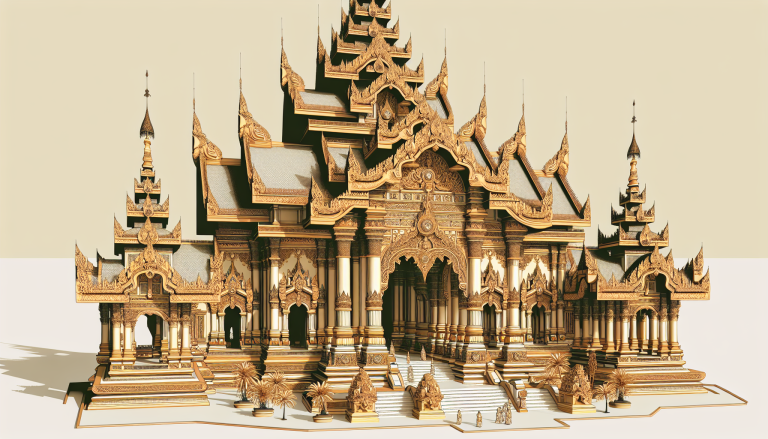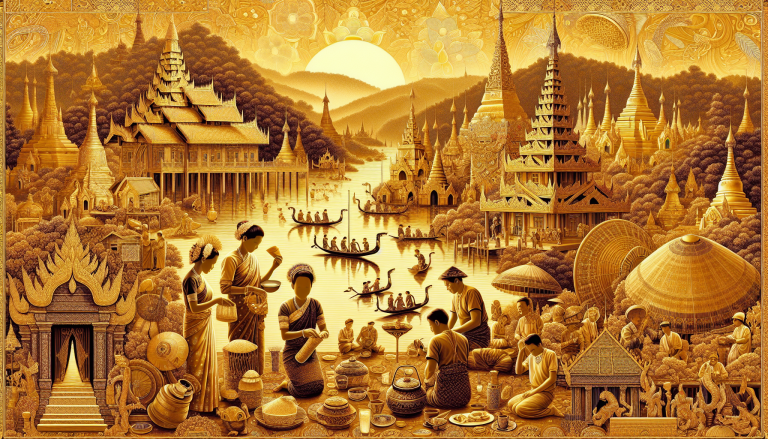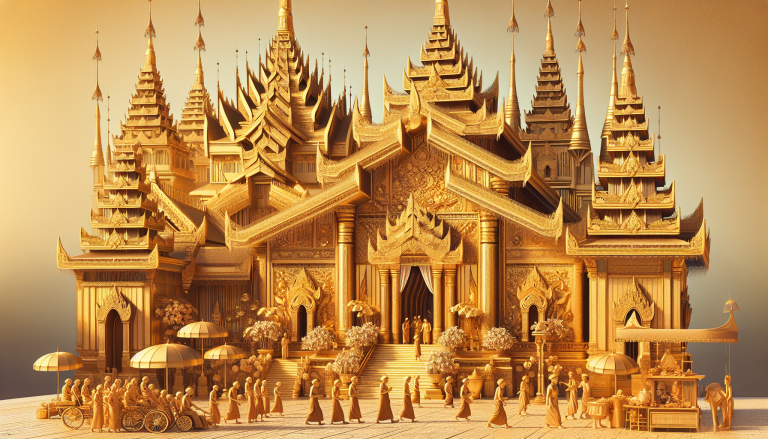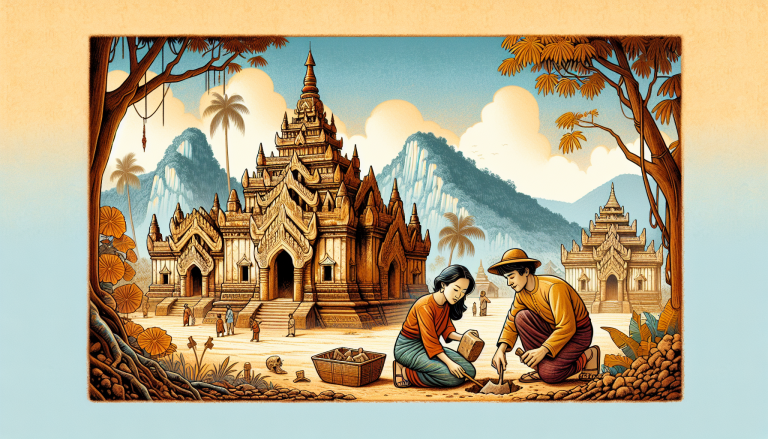A Glimpse into the Past: Theravada Buddhisms Legacy in Myanmar
Discover Theravada Buddhism in Myanmar: its history, core tenets, and influence on modern society. Travel through time!

Myanmar’s Relationship with Theravada Buddhism
Introduction to Theravada Buddhism
Theravada Buddhism, also known as “Southern Buddhism,” is one of the principal subdivisions of Buddhism and is influential in countries such as Sri Lanka, Cambodia, Thailand, Laos, and Myanmar. Theravada, which means “the Teaching of the Elders,” focuses on individual enlightenment and is grounded in the original teachings of the Buddha. Practitioners aim to reach Nirvana by following the Eightfold Path.
In Myanmar, this form of Buddhism has deeply rooted itself into the culture and daily life of its people. Myanmar is considered the most religious Buddhist country in terms of the proportion of monks and income spent on religious activities (Wikipedia).
| Country | Predominant Religion | Percentage of Buddhist Population |
|---|---|---|
| Myanmar | Theravada Buddhism | 90% |
| Sri Lanka | Theravada Buddhism | 70.2% |
| Cambodia | Theravada Buddhism | 95% |
| Thailand | Theravada Buddhism | 93.2% |
| Laos | Theravada Buddhism | 66% |
Spread and Influence in Myanmar
Theravada Buddhism was introduced to Myanmar from India around the Common Era, during the period when the Pyu city-states were flourishing. As time went on, kingdoms such as the Pagan Kingdom adopted Theravada Buddhism, integrating Buddhist teachings into the governance system. The kings were seen as righteous rulers who upheld and maintained the Buddhist tradition.
Historical records indicate that Theravada Buddhism began to overshadow other religious influences such as Hinduism, Mahayana Buddhism, and local spirit worship (nat worship) by the 13th century. Despite the official support for Theravada Buddhism, these other practices continued to coexist with it for many centuries.
Key figures such as King Anawrahta played a crucial role in the spread and establishment of Theravada Buddhism in Myanmar. King Anawrahta’s reign in the 11th century marked a significant period for the consolidation of Theravada Buddhism, as he promoted Buddhist teachings while allowing the worship of nat spirits. This period saw a syncretic blend of various religious beliefs, although Theravada Buddhism slowly began to dominate.
The formalization of Theravada Buddhism as a state religion occurred in 1961. Since then, it has deeply impacted Myanmar’s political and social dynamics. Today, you can witness the pervasive influence of Theravada Buddhism throughout the nation, from the numerous pagodas that dot the landscape to the massive number of monks and nuns devoted to maintaining the Sangha—the monastic community.
For further insights into the rich history of Myanmar, you may explore myanmar history and culture, ancient myanmar civilizations, and bagan kingdom history. Discovering the intricacies of Theravada Buddhism in Myanmar offers a fascinating glimpse into how spiritual beliefs have shaped this unique country.
Core Tenets of Theravada Buddhism
Understanding the core tenets of Theravada Buddhism gives you a deeper appreciation of its influence in Myanmar. These principles govern the beliefs and practices of adherents, shaping their spiritual journey and everyday life.
Original Teachings of the Buddha
Theravada Buddhism believes it has remained closest to the original teachings of the Buddha. Central to these teachings are the Four Noble Truths and the Noble Eightfold Path (BBC):
- The Four Noble Truths:
- Dukkha (Suffering): Life contains inherent unsatisfactoriness and suffering.
- Samudaya (Origin): The cause of suffering is desire and attachment.
- Nirodha (Cessation): Ending desire and attachment can lead to the cessation of suffering.
- Magga (Path): The way to end suffering is through the Noble Eightfold Path.
- The Noble Eightfold Path:
- Right Understanding
- Right Intent
- Right Speech
- Right Action
- Right Livelihood
- Right Effort
- Right Mindfulness
- Right Concentration
This path represents a comprehensive system of training that begins with the development of virtue, followed by concentration and mental cultivation, culminating in the development of wisdom (BuddhaNet).
Monastic Training and Precepts
Monastic life in Theravada Buddhism is governed by a stringent set of rules known as the Vinaya. Monks and nuns follow 227 precepts that guide their conduct and practice (BBC):
| Precept | Description |
|---|---|
| 1 | Refrain from harming living beings |
| 2 | Refrain from taking what is not given |
| 3 | Refrain from sexual misconduct |
| 4 | Refrain from false speech |
| 5 | Refrain from intoxicating drinks and drugs |
These precepts form the foundational ethics for all Buddhists, including lay followers who undertake the first five.
Monastic training in Theravada Buddhism emphasizes the importance of meditation and concentration as vital elements of the path to enlightenment. Monastic life is designed to create an environment conducive to developing virtue, concentration, and wisdom. This emphasis on self-liberation through personal effort is a hallmark of Theravada practice, distinguishing it from other Buddhist traditions.
For more on the historical adoption and evolution of Theravada Buddhism in Myanmar, explore our section on the Evolution of Theravada Buddhism in Myanmar.
This deep adherence to ancient practices and teachings not only defines individual spirituality but also shapes Myanmar’s cultural landscape. For travelers interested in delving into this spiritual journey, exploring historical sites in Myanmar related to Buddhism can offer a profound window into the country’s rich heritage.
Evolution of Theravada Buddhism in Myanmar
Historical Adoption and Development
The evolution of Theravada Buddhism in Myanmar is deeply intertwined with the country’s history. The Bamar people adopted Buddhism during the reign of King Anawrahta in the 11th century. This transformative period saw the Bagan Kingdom rise to become a major power in the region. Initially, Bagan’s Buddhism was eclectic, incorporating Mahayana and Vajrayana elements alongside animist practices and influences from Brahmanism.
Despite royal favor towards Theravāda Buddhism, various religious influences, including nat worship, esotericism, Mahayana, and Hinduism, persisted in Burmese Buddhism. This blend of practices continued to shape the region’s spiritual landscape, ultimately culminating in a unique Burmese Buddhist tradition that incorporated local customs and beliefs.
King Anawrahta’s Religious Reforms
King Anawrahta’s reign marked a significant turning point in the history of Theravada Buddhism in Myanmar. Realizing the need for a more orthodox form of Buddhism, Anawrahta invited Theravāda scholars from the Mon lands to revitalize the religious practices in his kingdom. These scholars focused on Pali learning and Abhidhamma philosophy, aiming to establish a purer form of Theravāda Buddhism (Wikipedia).
Anawrahta’s religious reforms included the importation of the Sri Lankan Mahavihara school to Burma. This initiative led to the gradual assimilation of Mon Buddhist culture into Bamar society, fostering a more unified religious tradition. Despite these efforts, local animist rites, Naga worship, and Brahmanical practices continued to be part of Bagan Theravāda Buddhism, reflecting the complex spiritual landscape of the region.
| Period | Key Developments | Influences |
|---|---|---|
| 11th Century | Adoption of Buddhism by Bamar people | Mahayana, Vajrayana, Animism, Brahmanism |
| Reign of King Anawrahta | Religious reforms and importation of Sri Lankan Mahavihara school | Mon Buddhist culture |
| Centuries After Anawrahta | Gradual spread of Theravāda Buddhism | Local animist rites, nat worship, Hinduism |
King Anawrahta’s encouragement of Burmese nat spirit worship alongside Buddhist practices further demonstrates the syncretic nature of Myanmar’s religious history. Although he supported some Mahayana practices, his reign laid the foundation for the dominance of Theravāda Buddhism. This dominance, however, was a gradual process spanning centuries, with various religious influences remaining influential until around the 13th century (Wikipedia).
To learn more about the historical developments in Myanmar, check out our articles on the bagan kingdom history and significant myanmar historical events.
Delve deeper into the cultural fabric of Myanmar by discovering its unique religious practices and the fascinating stories of its ancient civilizations.
Theravada Buddhism in Modern Myanmar
State Religion and Sangha’s Role
Theravada Buddhism is deeply ingrained in Myanmar’s cultural and political fabric. With around 88% of the population adhering to this faith, it holds a special status enshrined in the country’s constitutions, both past and present. Other religions, like Islam, Christianity, Hinduism, and Nat worship, are officially recognized as well, reflecting the religious diversity within the country.
The monastic community, known as the Sangha, plays a pivotal role in upholding and propagating Buddhist teachings. The Sangha’s influence reaches into various aspects of daily life, promoting moral behavior and spiritual guidance. Despite their central position, Buddhist monks are barred from voting or running for political office. This separation underscores the unique relationship between Buddhism and the state.
| Religion | Percentage of Population |
|---|---|
| Theravada Buddhism | 88% |
| Christianity | 6% |
| Islam | 4% |
| Hinduism | 0.5% |
| Nat Worship | 1.5% |
Impact on Political and Social Dynamics
Theravada Buddhism’s impact on Myanmar’s political and social climate is profound. Historically, righteous Buddhist kings ruled by integrating Buddhist principles into governance, maintaining order, and fostering religious practices (USIP).
In contemporary Myanmar, the link between Buddhism and politics has evolved. Following the 2021 coup, the Sangha’s involvement in politics has diminished, marking a departure from its previous prominent role in political struggles (Crisis Group). This shift has created opportunities for new leadership within resistance movements, particularly among youth and young women, a significant change from the traditional male leadership of elderly Burman Buddhist monks.
Understanding how Theravada Buddhism influences Myanmar’s social fabric involves exploring the interactions between religion and day-to-day life. The close relationship between the state and religious practices affects public ceremonies, legal systems, and social norms. For a deeper dive into Myanmar’s political and social structures, you can explore our article on myanmar political structures and myanmar history and culture.
By examining both the historical and current roles of Theravada Buddhism, you gain insight into how this ancient faith continues to shape Myanmar’s identity. Whether you’re delving into myanmar history books or exploring historical sites in Myanmar, the influence of Buddhism is ever-present, offering a window into the heart of this vibrant nation.






